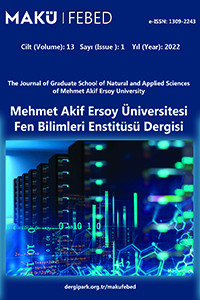Kayaağıl (Uşak) Termal Sularının Hidrojeoloji ve Hidrojeokimyasal İncelemesi
Termal su, hidrojeoloji, hidrojeokimya, Kayaağıl
Hydrogeological and Hydrogeochemical Investigation of Kayaağıl (Uşak) Thermal Waters
Kayaağıl Thermal water, hydrogeology, hydrogeochemistry, Uşak,
___
- Akgöz, R. (2011). Uşak-Merkez-Kayaağıl Köyü-Kurşuntaşı Mevkii, 2011/64-02 Numaralı Arama Ruhsatı İşletme Projesi, Uşak Belediyesi (yayınlanmamış)
- Arnorsson, S., Gunnlaugsson, E., and Svavarsson, H. (1983a). The Chemistry of Geothermal Waters in Iceland-II. Mineral Equlibria and Independent Variables Controlling Water Compositions. Geochim. Cosmochim. Acta, 47, 547–566.
- Arnorsson, S., Gunnlaugsson, E., Svavarsson, H. (1983b). The Chemistry of Geothermal Waters in Iceland III. Chemical Geothermometry in Geothermal Investigations. Geochim. Cosmochim. Acta, 46, 1513–1532.
- Davraz, A. (2008). Hydrogeochemical and Hydrogeological Investigations of Thermal Waters in the Usak Area (Turkey). Environ Geol, 54:615–628.
- Ercan, T., Dinçel, A., Metin, S., Türkecan, A., Günay, E. (1978). Geology of the Neogene Basins in Uşak Region. Bulletin of the Geological Society of Turkey, 21: 97-106 (in Turkish)
- Fournier, R.O. (1977). A Review of Chemical and Isotopic Geothermometers for Geothermal Systems. In: Proceedings of the Sym. On Geoth. Energy, Cento Scientific Programme, Ankara, 133-143.
- Fournier, R.O. (1979). A Revised Equation for the Na-K Geothermometer. Geothermal Res. Council Trans., 3: 221-224.
- Gibbs, R.J. (1973). Mechanisms to Trace Metal Transport in Rivers. Science, 180:71-173.
- Giggenbach, W.F., Gonfiantini, R., Jangi, B.L., Truesdell, A.H. (1983). Isotopic and Chemical Composition of Parbati Valley Geothermal Discharges, NW Himalaya, Indiana. Geothermics, 5: 51-62.
- Giggenbach, W. F. (1988). Geothermal Solute Equilibria: Derivation of Na-K-Mg-Ca Geoindicators, Geochimica et Cosmochimica Acta, 52, 2749-2765.
- Giggenbach, W.F., Corrales, R.S. (1992). The Isotopic and Chemical Composition of Waters and Steam Discharges from Volcanic-Magmatic-Hydrothermal Systems of the Guanacoste Geothermal Province, Costa Rica. Applied Geochemistry, 7: 309-332.
- Gökgöz, A., Özkul, M., Kaya, A., Hançer, M., Baykara, O., Örü, Z., Akın, T., Minissale, A. Vaselli, O. (2011). Farklı Rezervuarlara Sahip Uşak İli Jeotermal Alanlarının Kavramsal Hidrojeokimyasal Modellenmesi, 108Y016 nolu TÜBITAK Projesi raporu
- İça, M. (1979). Geology and Hydrogeology Investigations of Uşak-Eşme-Örencik spa. J Geol Eng Ankara, 37–46.
- Kharaka, Y.K., Gunter, W.D., Affarwall, P.K., Perkins, E.H., De Braall, J.D. (1988). SOLMINEQ (a computer program code for geochemical modelling of water-rock interactions). In: US Geological Survey Water Investigations, Report 88-4227
- Makris, J. (1985). Geophysical and Geodynamic Implications for the Evolution of the Hellenides. In: Stanley DI, Wezel FC (eds) Geological Evolution of the Mediterranean Basin. Springer, New York, pp 23–269.
- Mc Kenzie, D.P. (1978). Active Tectonics of the Alpine-Himalayan belt: the Aegean and the Surrounding Regions. Geophys J R Astron Soc 55:217–254
- MTA (1980). 1:50.000 Ölçekli Jeoloji Haritası Serisi, Uşak-K22-c (Derleyenler: Tuncay Ercan ve Ali Dinçel)
- Mutlu, H., Guleç, N. (1998). Hydrogeochemical Outline of Thermal Waters and Geothermometry Applications in Anatolia (Turkey). J Volcanol Geotherm Res 85:495–515.
- Nieva, D., Nieva, R. (1987). Developments in Geothermal Energy in Mexico, Part 12- Acationic Composition Geothermometer for Prospecting Geothermal Resources. Heat Recovery Systems, 7:243-258
- Piper, A.M. (1944). A Graphic Procedure in the Geochemical Interpretation of Water Analyses. Transactions - American Geophysical Union, 25, 914-928.
- Tezcan, A.K. (1979). Geothermal Studies, Their Present Status and Contribution to Heat Flow Contouring in Turkey. In: Cermac V, Rybach L (eds) Terrestrial Heat Flow in Europe. Springer, Berlin, pp 283–292.
- Truesdell, A.H. (1976). Summary of Section III Geochemical Techniques in Explanation. In: Proceedings, Second United Nations Symposium on the Development and Use of Geothermal
- Resources. San Francisco, V.1, Washington DC, US Government Printing Office
- TSE (2005). İnsani Tüketim Amaçlı Sular. Türk İçme Suyu Standartları TS 266 Sayılı Standart -Türk Standartları Enstitüsü –Ankara.
- WHO (2011). Guidelines for Drinking-Water Quality, 4th edn. World Health Organization, WHO Library Cataloguing-in-Publication Data, ISBN 9789241548151
- Yayın Aralığı: Yılda 2 Sayı
- Başlangıç: 2010
- Yayıncı: Burdur Mehmet Akif Ersoy Üniversitesi
Mehmet Rafet KISTIR, Duygu KURTOĞLU
Blokzinciri Teknolojisi ve Yakın Gelecekteki Uygulama Alanları
Karacaören I Baraj Gölünün Kuş Faunası
Halil SUEL, İdris OĞURLU, Emrah Tagi ERTUĞRUL
Kayaağıl (Uşak) Termal Sularının Hidrojeoloji ve Hidrojeokimyasal İncelemesi
Üç Farklı Kızılçam Populasyonu Fidanlarının Morfolojik Özellikleri
Halil Barış ÖZEL, Cengiz YÜCEDAĞ, Volkan AYDINHAN
Görüntü Analizi Yöntemlerinin Geoteknik Mühendisliğinde Kullanımı
Tarihi Binalarda Yangına Karşı Korunma ve Mevzuatın İrdelenmesi
İbrahim İskender SOYASLAN, Kerem HEPDENİZ
Bina İçlerinde Depremin Zararlarını Önleyici Mekansal Tasarım Yaklaşımları
Latif Gürkan KAYA, Cengiz YÜCEDAĞ, Hüseyin Samet AŞIKKUTLU, Hale ÇOKYİĞİT
